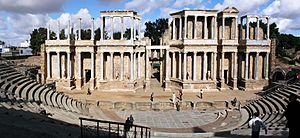Masona facts for kids
Masona (who died around 600 or 610 AD) was an important leader in the city of Mérida. He was the bishop and a top church leader for the whole region of Lusitania (which is now part of Spain and Portugal). He started his work around 570 AD. Masona was well-known for practically running Mérida while he was bishop. He also created the first confirmed hospital in Spain.
Masona was a Visigoth, a group of people who ruled Spain at that time. He was born into the Arian Christian faith but later became a Catholic. His biographer, who wrote about his life, said that even though Masona was a Goth, he was very dedicated to God as a Catholic. He joined the church when he was young. He worked at the Basilica of Saint Eulalia in Mérida, a church rebuilt by Bishop Fidelis. People believed Masona had a special connection with Saint Eulalia. They said his prayers, along with her help, ended a terrible plague in the region. Masona was likely educated in a similar way to other smart people of his time, like Leander of Seville.
Contents
Helping the City of Mérida
Masona did a lot to help the people of Mérida.
Building a Hospital and Hostel
In 580 AD, Masona built a xenodochium. This was like a large inn or hostel for travelers. It also included a hospital for sick people. What was special about this place was that it welcomed everyone, including Jews and even pagans. His biographer thought this was a very good thing.
Public Healthcare and Food
Masona also set up a system for public healthcare. Doctors would visit different parts of the city to find sick people. Then, they would bring them to the hospital for care. Many travelers came to Mérida to visit the shrine of Saint Eulalia, who was the city's patron saint. The hospital got its food from farms that Masona dedicated just for that purpose.
Masona also started a program to give out free wine, corn, oil, and honey. This food was for the people living in the city and also for the farmers in the countryside.
Public Loans
He also created a system for public credit. He put 2,000 solidi (a type of coin) at the basilica. Citizens could take out loans from this money. It's thought that the church might have had a similar system even before Masona became bishop.
Challenges with King Leovigild
In his early years, Masona got along with the Arian king Leovigild. Masona even gave a sermon comparing King Leovigild to God, saying both should be respected.
Religious Conflict
Later, King Leovigild tried to convince Masona to change back to the Arian faith. He used persuasion, arguments, threats, and even gifts, but Masona refused. Leovigild then ordered a group to decide who should control the important Eulalian basilica, the Arians or the Catholics. Even though most of the group were Arians, they decided in favor of the Catholics.
Masona's Exile
In 582 AD, King Leovigild came to Mérida. He supported the Arian church and appointed an Arian bishop named Sunna. Masona and Sunna had lived peacefully together before this. Leovigild ordered that some Catholic churches be given to Sunna's Arian church. When Masona refused, he was called to Toledo.
The king then demanded that Masona hand over the tunic of Eulalia. This was the most sacred relic in Mérida. Masona cleverly tricked the king and managed to keep the tunic safe. Because Masona did not obey the king's order, he was sent away from Mérida. This was likely because Masona was very powerful in the city. He was also linked to a rebellion by Hermenegild that the king was trying to stop.
While Masona was in exile, his supporters sent him 2,000 solidi to live on. Another Catholic bishop, Nepopis, took his place for a short time. Masona was allowed to write letters. After three years, in 585 AD, Masona was allowed to return to Mérida. This happened around the same time that John of Biclarum, another Catholic Visigoth, also returned from exile.
Later Plots
In 588 AD, after the new king, Reccared I, became Catholic, Sunna and others planned to kill Masona. They also wanted to set up a different king, named Segga. But their plot was discovered by a count named Witteric. Sunna then chose to leave the country and went to Mauretania.
Later Life and Death
Masona attended an important church meeting called the Third Council of Toledo in 589 AD. He was the first Catholic bishop listed there, showing his importance. He was still a bishop at another meeting in Toledo in 597 AD.
Helping Slaves
When Masona was very sick and thought he was dying, he freed some of the church's slaves. He also gave them small pieces of land to live on. This was against the law at the time, as the church was supposed to be paid for losing their services. The archdeacon, Eleutherius, was supposed to take over the diocese until a new bishop was chosen. He probably would have undone Masona's actions. But Eleutherius surprisingly died before Masona, who then recovered from his illness. Masona's gifts of land were meant to make sure the freed slaves truly had their new freedom.
A letter that might be from Isidore of Seville to Masona, dated 606 AD, suggests Masona died after that year. However, we are not sure if this letter is real. The main story of Masona's life comes from a book called Vitas sanctorum patrum Emeritensium (Lives of the Holy Fathers of Mérida). This book tells more about Masona than about the other important church leaders of Mérida, Paul and Fidelis. Masona was followed as bishop by someone named Renovatus.
See also
In Spanish: Masona para niños


